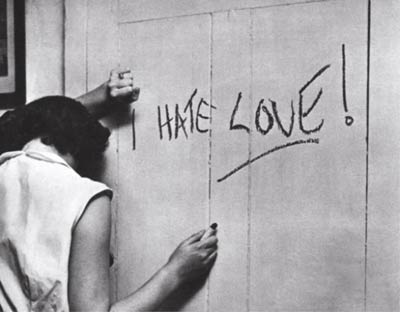new york
They take apart their nightmares and they leave them by the door
Over the last several months, 22,741 New Yorkers contacted the city’s Department of Sanitation and arranged for the pickup of refrigerators, air-conditioners and freezers. In more than 11,000 instances, the machines vanished before sanitation workers arrived in their white trucks to pick them up.
Who, then, is stealing the household appliances of New York City?
Scavengers, to be sure, abound in New York, especially during tough economic times. But the sheer magnitude of the thefts — 11,528 appliances, to be precise — over a relatively brief period suggests to some in city government and the recycling industry that a more organized enterprise may be at work as well.
‘The procedure which consists of endlessly finding some novelty in order to escape the preceding results is offered up to agitation, but nothing is more stupid.’ –George Bataille

The usual black bottom strip on those signs has been replaced by a colorful set of horizontal lines, evoking the aesthetic of the subway map. The transportation authority’s circular blue logo now sits atop the poster, astride a helpful “.info” to direct passengers to the authority’s Web site. The MTA worked with its longtime agency, Korey Kay Partners, the agency that created the “SubTalk” motto in 1993.
‘Life is a business that does not cover the costs.’ –Schopenauher

It has been a year since I drove a cab, but the old garage still looks the same. (…)
Shape-up time at Dover Taxi Garage #2 still happens every afternoon, rain or shine, winter or summer, from two to six. That’s when the night-line drivers stumble into the red-brick garage on Hudson Street in Greenwich Village and wait for the day liners, old-timers with backsides contoured to the crease in the seat of a Checker cab, to bring in the taxis. The day guys are supposed to have the cabs in by four, but if the streets are hopping they cheat a little bit, maybe by two hours. That gives the night liners plenty of time to stand around in the puddles on the floor, inhale the carbon monoxide, and listen to the cab stories.
Cab stories are tales of survived disasters. They are the major source of conversation during shape-up. (…)
A year ago or so, any woman hanging out at shape-up was either waiting to report a driver for stealing her pocketbook, a Dover stiff’s girl friend, or some sort of crazy cabdriver groupie. In those days, the two or three women who were driving were banned from the night line, which is notably unfair because you can make a lot more money with a lot less traffic driving at night. Claire, a long-time Dover driver, challenged the rule and won; now fifteen women drive for Dover, most on the night line. (…)
It doesn’t take a cabdriver too long to realize that once you leave the joy of shape-up and start uptown on Hudson Street, you’re fair game. You’re at the mercy of the Fear Variables, which are (not necessarily in order): the traffic, which will be in your way; the other cabdrivers, who want to take your business; the police, who want to give you tickets; the people in your cab, lunatics who will peck you with nudges and dent you with knives; and your car, which is capable of killing you at any time. Throw in your bosses and the back inspectors and you begin to realize that a good night is not when you make a living wage. That’s a great night. A good night is when you survive to tell your stories at tomorrow’s shape-up. But all the Fear Variables are garbage compared with the Big Fear. The Big Fear is that times will get so hard that you’ll have to drive five or six nights a week instead of three.
Of the many thousands of events canceled by the snow, it might have been convenient if Friday’s scheduled rollout of the great New York share-a-taxicab-with-a-stranger experiment of 2010 were not among them.
Alas.
Communal rides in the city’s yellow cab fleet will now start Wednesday, the Taxi and Limousine Commission said.
The share-a-cab program will allow up to four passengers to ride carpool-style along three preset routes in Manhattan, at a flat fare of $3 or $4 a head. Drop-offs will be allowed along Park Avenue down to Grand Central Terminal. For now, shared rides will only be allowed between 6 and 10 a.m. on weekdays.
photo { David Stewart }
we own the night
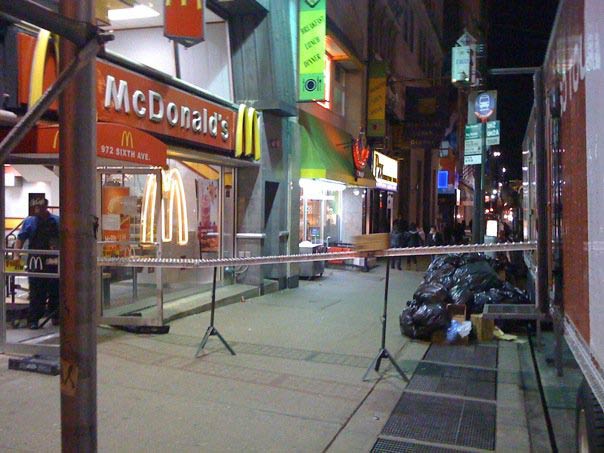
{ the adventures of imp on 6th avenue, december 7, 2010, 11pm }
‘All I can do is be me, whoever that is.’ –Bob Dylan
Men and women have been pairing off since the dawn of humanity. For most of its history, marriage was an economic institution that created advantageous alliances between clans and was arranged, often, without much input from the bride or groom. But by the 19th century, many in the Western world had begun to marry for love, making the relationship infinitely more complicated and divorce a lot more common.
Romantic love assumed a position of high value but even higher vulnerability.
Still, until the second half of the 20th century, these ubiquitous couplings went largely unstudied. What happened behind closed doors generally remained private, unless one had a particularly nosy set of in-laws or a manner of fighting that necessitated police intervention.
Marriages, with the power to affect everything from personal income levels to mental and physical health, remained a hazy mystery. But with the advent of the affordable video camera in the late 1960s, psychologists began recording couples’ interactions. The scientists hooked up their subjects to monitors that detected changes in blood pressure or stress hormones, and then coded even their slightest movements — an eye roll or a knuckle crack. The couples were interviewed about their marital satisfaction and were, in some cases, tracked for years.
{ Washington Post | Continue reading }
Unhappy couples in New York have long gone to extremes to throw off the shackles of matrimony—in the worst cases, framing their spouses, producing graphic testimony about affairs, or even confessing to crimes they did not commit. All this will fade into the past if, as expected, Gov. David Paterson signs a bill making New York the last state in the country to adopt unilateral no-fault divorce.
Their counterparts in other states have had it much easier. California adopted the first no-fault divorce bill in 1970; by 1985, every other state in the nation—but one—had passed similar laws. In New York, the miserably married must still charge each other with cruel and inhuman treatment, adultery or abandonment—or wait one year after a mutually agreed legal separation—in order to divorce.
‘Taste is made of a thousand distastes.’ –Paul Valéry
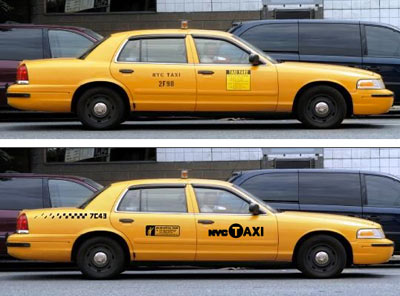
The Ford Crown Victoria has long been the most widely used vehicle in New York City’s taxi fleet. But Ford is retiring the Crown Vic next year, and that means NYC needs to find a replacement.
Enter the Taxi of Tomorrow competition, a project created by city officials to find the next major taxi model.
So far, the city has narrowed the competition down to three finalists. The winner, which will be picked next year, will have an exclusive contract to provide the city with taxi cabs.
{ Fast Company | Continue reading }
In 2007, TLC’s Board of Commissioners approved a new package of taxi stickers. Smart Design, a design firm, produced and donated the new logo designs to TLC.
Taxi drivers and owners purchased the stickers from authorized printers.
The 4 stickers (per vehicle side) in the logo package were: a fare panel, the NYCTAXI sticker, the medallion number and a checker stripe decal.
We tote big guns, and everybody know somebody that know somebody that know somethin’ about it

New York City in the 1920s and ’30s was a hotbed of criminal activity. Prohibition laws banning the production, sale and distribution of alcohol had been introduced, but instead of reducing crime, they had the opposite effect. Gangsters organized themselves and seized control of the alcohol distribution racket, smuggling first cheap rum from the Caribbean, then French champagne and English gin, into the country. Speakeasies sprang up in every neighbourhood, and numbered more than 100,000 by 1925. When prohibition was abolished in 1933, the gangsters took to other activities, such as drug distribution, and crime rates continued to increase.
At the forefront of the city’s efforts to keep crime under control was a man named Carleton Simon. Simon trained as a psychiatrist, but his reach extended far beyond the therapist’s couch. He became a ‘drug czar’ six decades before the term was first used, spearheading New York’s war against drug sellers and addicts. He was a socialite and a celebrity, who made a minor contribution to early forensic science by devising new methods to identify criminals. He also tried to apply his knowledge to gain insights into the workings of the criminal brain, becoming, effectively, the first neurocriminologist.
Simon was born in New York City on February 28th, 1871, and studied in Vienna and Paris, graduating with an M.D. in 1890. Afterwards, he conducted sleep research. (…) Eventually, Simon became interested in criminology and psychopathology, and by the turn of the century had abandoned his psychiatric research to focus on these disciplines. (…)
Towards the end of the 1930s crime was estimated to cost the U.S. approximately $15 billion annually. Knowledge of brain function and dysfunction was very rudimentary by today’s standards, and criminals and psychopaths were often lobotomized or subjected to electroconvulsive therapy in order to keep them under control. Another treatment available was insulin shock therapy, which had been introduced by Manfred Sakel in 1933, and involved giving patients large repeated doses of the hormone to induce coma. It was around this time that Simon proposed a new theory, which he believed would help science to understand and control the criminal mind.
The theory drew on the concept of cerebral dominance, which had emerged some 70 years earlier, largely from Paul Broca’s investigations of stroke patients. (…) According to Simon’s theory, criminality occurs as a result of a shift in cerebral dominance, whereby the normally submissive right hemisphere gains mastery of the brain, leading to irrational behaviour.
photo { Alessandro Zuek Simonetti }
Catch me swoopin Bentley coupe and switchin lanes

New Yorkers are accustomed to strong odors, but several years ago a new aroma began wafting through the city’s streets, a smell that was more unnerving than the usual offenders (trash, sweat, urine) precisely because it was so delightful: the sweet, unmistakable scent of maple syrup. It was a fickle miasma, though, draping itself over Morningside Heights one afternoon, disappearing for weeks, reemerging in Chelsea for a few passing hours before vanishing again. Fearing a chemical warfare attack, hundreds of New Yorkers reported the smell to authorities. (…) The city quickly determined that the odor was harmless, but the mystery of its origin persisted for four years.
During maple syrup events, as they came to be called, operators at the city’s popular NYC311 call center—set up to field complaints and provide information on school closings and the like—were instructed to reassure callers that they could go about their business as usual.
But then city officials had an idea. Those calls into the 311 line, they realized, weren’t simply queries from an edgy populace. They were clues.
On January 29, 2009, another maple syrup event commenced in northern Manhattan. The first reports triggered a new protocol that routed all complaints to the Office of Emergency Management and Department of Environmental Protection, which took precise location data from each syrup smeller. Within hours, inspectors were taking air quality samples in the affected regions. The reports were tagged by location and mapped against previous complaints. A working group gathered atmospheric data from past syrup events: temperature, humidity, wind direction, velocity.
Seen all together, the data formed a giant arrow aiming at a group of industrial plants in northeastern New Jersey. A quick bit of shoe-leather detective work led the authorities to a flavor compound manufacturer named Frutarom, which had been processing fenugreek seeds on January 29. Fenugreek is a versatile spice used in many cuisines around the world, but in American supermarkets, it’s most commonly found in the products on one shelf—the one where they sell cheap maple-syrup substitutes.
Fifteen months after the Maple Syrup Mystery was solved, mayor Michael Bloomberg paid a visit to the 311 call center. (…) Launched in March 2003, 311 now fields on average more than 50,000 calls a day, offering information about more than 3,600 topics: school closings, recycling rules, homeless shelters, park events, pothole repairs. The service has translators on call to handle some 180 different languages.
photo { Mark Borthwick }
The same 2-step wit a lil’ twist
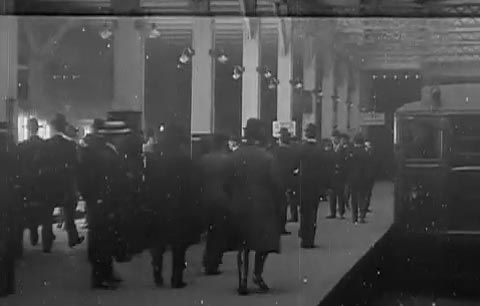
{ Interborough Subway, 14 St. to 42nd St., New York, May 21, 1905 | More: Brooklyn to New York via Brooklyn Bridge, 1899 | video }
related { 50 Reasons to Be Pretty Damn Euphoric You Live in New York City }
Semi suite

You write in Art is Work that the very famous “I ‘Heart’ New York” logo you designed was originally proposed as something else.
It was just a little typographical solution with two lozenges and a word in it, two ovals, and the word inside it; it was not in any way distinguished. But I always thought the whole thing was going to be a three-month campaign.
{ Interview with Milton Glaser | The Believer | Continue reading | Images: I Love NY and New York magazine logotypes designed by Milton Glaser | video: The “I Love New York” Ad Campaign Origin }
related { An Introduction to Graphic Design | Design Observers | full story }
‘They talk of the dignity of work. The dignity is in leisure.’ –Herman Melville

The Return of the Three-Martini Lunch
If you have a mixologist making complicated drinks from esoteric-sounding ingredients, people don’t even feel guilty that they’re drinking. Jon Kamen, chairman and CEO of New York-based production company @radical.media, doesn’t. He only goes out to lunch once a week, but when he does, he often goes to EN Japanese Brasserie and orders a drink, such as their combination of Japanese liquor shochu and oolong tea. “They’ve created certain cocktails that I don’t look at as a drink so much as a complement to the meal I’m having,” he says.
photo { Sarah Lucas }
Hypnosisss can cure you of your psssychosssis

Nobody asked me, but the building was designed for the Astor Estate by Herman Lee Meader, a Harvard-trained architect who gave legendary parties and kept a boa in his penthouse.
{ Christopher Gray | Photo: Ray Sawhill }
Herman Lee Meader (died February 14, 1930 at 55) was an American architect and author. He designed several prominent buildings in Manhattan, both commercial and residential, as well as much work on the Astor estate, including the Waldorf building located at 8 west 33rd St., then the heart of the fashionable shopping district. Meader lived in the Waldorf Building penthouse, where he created a surrounding rooftop Italian garden. There he held elaborate parties which attracted musicians, artists, writers, prizefighters, chess players and others—at one, Meader staged a fight between a black snake and a king snake.
bonus [click to enlarge]:
{ NY Times }
Kod knows. Anything ruind. Meetingless.
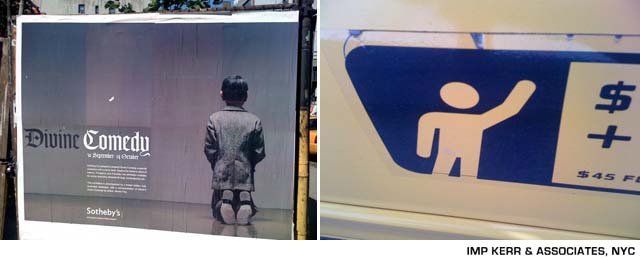
Is it Easy to be an Urban New York Ant?
If scientists learn how critters adapt to difficult-to-colonize locations (especially ants, which colonize just about every available habitat, and are able to make quick decisions), they will be more likely to learn how to maintain biodiversity in more readily habitable locations.
With this goal in mind, Marko Pecarevic and coworkers have studied ant life on street medians in New York City.
Why study ant life on street medians?
Current hypotheses state that wider street medians should host more species. This is an extrapolation from analogous studies in natural environments.
However, there’s good reason to suspect that unique features of urban life may result in different ecological adaptations. Human disturbance, for example, may be more prevalent on wider street medians, disrupting the local urban ecology.
Furthermore, it’s possible that ants treat street medians either as habitable islands (surrounded by inhabitable pavement), or a connecting patchwork linking more habitable environments (e.g. plants in sidewalk cracks). These are the kinds of questions probed by Pecarevic and coworkers.
The scientists sampled ants from 44 street medians in New York City in July 2006. (…) The scientists collected over 6600 ants from 13 species and 11 genera (the next highest classification above species). Ninety-four percent of the ants were from one of three species. The first is non-native, and the latter two are native.
photo { Sotheby’s Divine Comedy billboard featuring Maurizio Cattelan, Him, 2001 + cab door, 10 Ave, between W 28th and W 29th st, Thursday, October 7, 2010 }
‘If you’re going to be crazy, you have to get paid for it or else you’re going to be locked up.’ –Hunter S. Thompson

Okay, we’ll be starting in a few moments… just waiting for the drugs to take effect. (…) I mentioned that, earlier in the show, a drug joke - and I hate to do that, because it creates a mess, and I’m not into drugs any more. I quit completely, and I hate people who are still into it.
{ Steve Martin’s Monologue | Saturday Night Live Transcript | Continue reading }
photo { Bruce Davidson, Coney Island, 1959 }
Ain’t no room 4 disagreein, uh? 1+1+1 is 3

Singapore math is taking hold in schools throughout the country. Here in New York City, home to the nation’s largest school system, a small but growing number of schools have adopted this approach, based on Singapore’s national math system.
Many teachers and parents here say Singapore math helps children develop a deeper understanding of numbers and math concepts than they gain through other math programs.
artwork { Jasper Johns, 0 through 9, 1960 }





